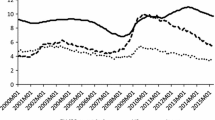Abstract
This paper investigates to what extent the observed nonlinearities in the unemployment rates of six major developed economies are the response to cyclical asymmetries. Two classes of models are compared: strict smooth transition autoregressions and models where the transition variable is GDP growth, which is considered a more direct indicator of the business cycle. The empirical evidence points out that nonlinearities in unemployment rates are induced by cyclical asymmetries. It is also found that in most countries the unemployment rate looks stationary and reverts to a long-run equilibrium rate in periods of normal growth, while in extreme cyclical situations it tends to become nonstationary as if each extreme cyclical episode had its own path of equilibrium.
Similar content being viewed by others
References
Cancelo, J. R., & Mourelle, E. (2005a). Modelling cyclical asymmetries in European imports. International Advances in Economic Research, 11(2), 135–147.
Cancelo, J. R., & Mourelle, E. (2005b). Modelling cyclical asymmetries in GDP: International evidence. Atlantic Economic Journal, 33(3), 297–309.
Chauvet, M., Juhn, C., & Potter, S. (2002). Markov switching in disaggregate unemployment rates. Empirical Economics, 27(2), 205–232.
Eitrheim, ∅., & Teräsvirta, T. (1996). Testing the adequacy of smooth transition autoregressive models. Journal of Econometrics, 74(1), 59–75.
Granger, C. W. J., & Teräsvirta, T. (1993). Modelling nonlinear economic relationships. Oxford: Oxford University Press.
Kapetanios, G., Shin, Y., & Snell, A. (2003). Testing for a unit root in the nonlinear STAR framework. Journal of Econometrics, 112(2), 359–379.
Krolzig, H., Marcellino, M., & Mizon, G. (2002). A Markov-switching vector equilibrium correction model of the UK labour market. Empirical Economics, 27(2), 233–254.
Montgomery, A., Zarnowitz, V., Tsay, R. S., & Tiao, G. C. (1998). Forecasting the U.S. unemployment rate. Journal of the American Statistical Association, 93(442), 478–493.
Neftçi, S. N. (1984). Are economic time series asymmetric over the business cycle? Journal of Political Economy, 92(2), 307–328.
Öcal, N., & Osborn, D. R. (2000). Business cycle non-linearities in UK consumption and production. Journal of Applied Econometrics, 15(1), 27–43.
Rothman, P. (1998). Forecasting asymmetric unemployment rates. Review of Economics and Statistics, LXXX(1), 164–168.
Skalin, J., & Teräsvirta, T. (2002). Modelling asymmetries and moving equilibria in unemployment rates. Macroeconomic Dynamics, 6(2), 202–241.
Teräsvirta, T. (1994). Specification, estimation, and evaluation of smooth transition autoregressive models. Journal of the American Statistical Association, 89(425), 208–218.
Teräsvirta, T. (1998). Modeling economic relationships with smooth transition regressions. In A. Ullah & D. Giles, (Eds.), Handbook of applied economic statistics (pp. 507–552). New York: Marcel Dekker.
Teräsvirta, T., & Anderson, H. M. (1992). Characterizing nonlinearities in business cycles using smooth transition autoregressive models. Journal of Applied Econometrics, 7(0), S119–S136.
Van Dijk, D., Teräsvirta, T., & Franses, P. H. (2002). Smooth transition autoregressive models – A survey of recent developments. Econometric Reviews, 21(1), 1–47.
Acknowledgments
A previous version was presented at the 61st International Atlantic Economic Conference, Berlin, Germany, March 15–19, 2006. The author thanks the conference participants and an anonymous referee for their comments and suggestions.
Author information
Authors and Affiliations
Corresponding author
Rights and permissions
About this article
Cite this article
Cancelo, J.R. Cyclical Asymmetries in Unemployment Rates: International Evidence. Int Adv Econ Res 13, 334–346 (2007). https://doi.org/10.1007/s11294-007-9094-y
Received:
Published:
Issue Date:
DOI: https://doi.org/10.1007/s11294-007-9094-y




